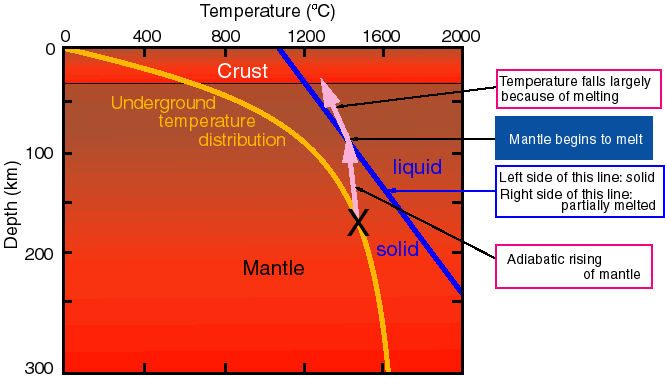What is magma?
Magma
is a silicate melt produced by partial melting from mantle.
In the depths of the earth, the mantle is very hot, but it is applied high pressure. Thereby the
mantle is in solid state. If this hot mantle comes up near the surface of the earth, then the
pressure goes down and it would be partially melted. This is nothing but the magma. A volcano
is formed where magma is generated. As seen in figure 1.

(1) Oceanic ridge
- Here, the plate tears and the hot mantle comes up from the depths and
partially melts which erupts to form a submarine volcano and to become the oceanic crust.
(2) Island arc
- An example: the Japanese Archipelago. Mantle upwelling induced by
subduction of oceanic plate at a trench Andesite magma, dacite magma (which has high SiO2
contents and by slow solidification becomes granitic plutons which constitute the continental
crust.)
(3) Hot spot
- Examples: the Hawaii Islands, Iceland. Mantle gushes up through a tube
(pipe-like conduit) from a heat source located much deeper than the plate whose thickness is
about 100 km.
Mechanism of magma generation
The yellow line in the figure below shows the relation between the temperature and the
depth under the ground. (Since the pressure depends on the depth, we can consider it as the
relation between the temperature and the pressure.)
The temperature of the mantle is, in general, lower than its melting point. Hence
the mantle is solid usually.
If there is a hot mass of mantle (temporally denoted by X in the figure), the
specific gravity of the mass is slightly lighter than the surrounding part, and it gradually goes up
(shown by the pink arrow in the figure).
Because the mantle is of low heat-conductivity (not easy to conduct heat), the
mass of mantle hardly cools while it rises up (adiabatic rising). Continuing to rise up, it would
finally begin to melt due to decompression. This is nothing but the magma generation.
Continuing to melt, the volume of magma increases, and then the magma is separated from the
mantle. Because the magma is light, it continues to go up. Finally it reaches the boundary
between the mantle and the crust, and piles up there. This is just the magma chamber.
The magma made thus is basaltic magma of which composition is the same as that of the
submarine crust or the lava flows on the Hawaii Islands.

Structure Of Magma Chamber And Its Mechanism
Let's explain the mechanism of magma chamber by taking the case of Mt. Sakurajima for
example. The underground structure of a volcano consists of upper magma chamber, lower
magma chamber and cumulate plug in between. The upper magma chamber is located in the
crust and the lower one around the boundary of the crust and the mantle. In the upper magma
chamber, crystallization of magma advances and the heavy crystals are deposited (cumulated) on
the floor. The deposits constitute the plug. The remaining is light dacite magma. When the
basaltic magma is newly supplied into the lower chamber by the rising of the mantle from the
depths (Fig. 1), the cumulate plug starts to sink down because it is heavy (Fig. 2). Hence, the
primary basaltic magma in the lower chamber moves up through openings (cracks) to the upper
chamber, and mixes with the dacite magma remained in the upper chamber to make a mixture,
andecite magma. This migration of magma from the lower to upper chambers continues until the
plug touches the bottom of the lower chamber. During this period, there occur several times of
large-scale volcanic eruptions, in which the extruded lava is accordingly dacite or andecite. After
the plug touches the floor of the lower magma chamber, a part of the plug is eroded and
removed away by the mantle flow (Fig. 3). On the other hand, crystallization proceeds in the
upper chamber, and heavy crystalline matter is deposited on the plug. And then new magma is
supplied into the lower magma chamber. Thus the above-mentioned process is repeated. In the
case of Mt. Sakurajima, it seems probable that this process would be repeated every 600 years.

Return to Table of Contents


